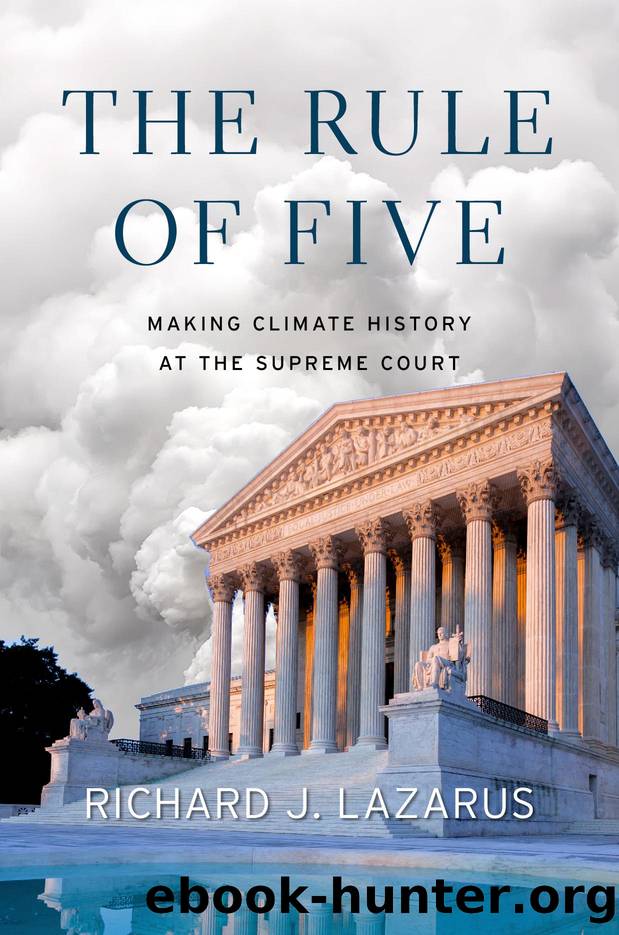The Rule of Five: Making Climate History at the Supreme Court by Richard J. Lazarus

Author:Richard J. Lazarus [Lazarus, Richard J.]
Language: eng
Format: epub
Tags: law, Courts, environmental, science, Global Warming & Climate Change
ISBN: 9780674238121
Google: 5SbMDwAAQBAJ
Publisher: Harvard University Press
Published: 2020-11-15T00:17:24.066523+00:00
15
A Hot Bench
As Jim Milkey began to speak, those in the Supreme Court Bar in the front of the courtroom shifted forward ever so slightly in their seats, eager to see which Justice would be the first to interrupt and ask a question. Most looked immediately to the one known for sporting a Cheshire-cat-like grin before ambushing his prey.
Justice Antonin Scalia had, after all, transformed oral argument. The number of questions the Justices asked almost doubled immediately after Scalia joined the Court in September 1986, increasing to an average of 104 questions per hour-long argument during Scaliaâs first year. By 2005, the year before Massachusetts was argued, the average number of questions asked by the Justices had ballooned to a whopping 156.1
From the minute he joined the Court, Scalia made his presence known. During the very first argument on his very first day on the bench, Scalia asked twenty-eight demanding questions.2 And during one two-week period that Supreme Court Term, which runs October to October, he asked 30 percent of all the questions posed by the Justices. In case after case, Scalia peppered arguing counsel with questions, prompting Justice Lewis Powell, an old-school Virginian who was well known for his polite demeanor, to quip to Justice Thurgood Marshall: âDo you think he knows the rest of us are here?â3
As a former law professor at the Universities of Virginia and Chicago, known for his lively questioning of students in the classroom, aggressive interrogations came naturally to Scalia. But this was more than just the judicial equivalent of classroom banter designed to ensure a full airing of the legal issues presented in a case. It was strategic.
Scalia had discovered upon joining the Court that his opportunity to influence the other Justices was extremely limited. By tradition, the Justices do not discuss with each other a case before oral argument. As described by Justice Kennedy, âBefore the case is heard, we have an unwritten rule: We donât talk about it with each other.â4 Even at the conference held one to two days after the argument, where they formally voted, there was no meaningful discussion. One at a time, each Justice would speak without interruption and announce his or her vote, along with a summary explanation. To his disappointment, the conference was ânot really an exercise in persuading each other.â5 Worse still, because Scalia was the most junior Justice, he was the last to speakâbefore he had uttered a word, all the other Justices had already announced their vote.6
So Scalia pivoted to the oral argument, the firstâand by far the longestâtime the Justices ever spoke about a case in one anotherâs company. As explained by Chief Justice Roberts, âWe come to it cold as far as knowing what everybody thinks, and so through the questioning, we are learning for the first time ⦠how [the other Justices] view the case and that can alter how you view it right on the spot.â7 To Scalia, the lesson was obvious. If he could use those sixty minutes wisely, he could press his views on the case to his colleagues before the conference vote.
Download
This site does not store any files on its server. We only index and link to content provided by other sites. Please contact the content providers to delete copyright contents if any and email us, we'll remove relevant links or contents immediately.
| Africa | Americas |
| Arctic & Antarctica | Asia |
| Australia & Oceania | Europe |
| Middle East | Russia |
| United States | World |
| Ancient Civilizations | Military |
| Historical Study & Educational Resources |
Never by Ken Follett(2880)
The Man Who Died Twice by Richard Osman(2300)
Machine Learning at Scale with H2O by Gregory Keys | David Whiting(2291)
Fairy Tale by Stephen King(2070)
Will by Will Smith(2042)
Rationality by Steven Pinker(1765)
The Dawn of Everything: A New History of Humanity by David Graeber & David Wengrow(1571)
The Dark Hours by Michael Connelly(1570)
Principles for Dealing With the Changing World Order: Why Nations Succeed and Fail by Ray Dalio(1373)
Friends, Lovers, and the Big Terrible Thing by Matthew Perry(1328)
A Short History of War by Jeremy Black(1300)
HBR's 10 Must Reads 2022 by Harvard Business Review(1256)
Go Tell the Bees That I Am Gone by Diana Gabaldon(1234)
Can't Hurt Me: Master Your Mind and Defy the Odds - Clean Edition by David Goggins(1227)
515945210 by Unknown(1208)
Fear No Evil by James Patterson(1109)
443319537 by Unknown(1073)
Works by Richard Wright(1018)
Going There by Katie Couric(991)
